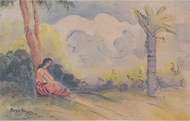![]() Traditional, Modern & Contemporary Indian Art
Traditional, Modern & Contemporary Indian Art
![]() Traditional, Modern & Contemporary Indian Art
RAMKINKAR BAIJ (1906 - 1980)
Traditional, Modern & Contemporary Indian Art
RAMKINKAR BAIJ (1906 - 1980)
RELATED LOTS
-
Provenance
 Provenance
Provenance
Acquired directly from the aritst by J. L Banerjee (Principal, Tirthapati Institution, Kolkata), thence by descent.
Acquired from the family by a Private Collector
-
Literature
 Literature
Literature

A pioneer of post-independence Indian art, Ramkinkar Baij was a student of Nandalal Bose of Shantiniketan and is most famous for his sculptures, but his paintings were notable too. This painting of goddess Kali is an excellent example of his mastery over watercolour paintings. Kali is the Devi for destruction of evil. She is the eternal form of the whole world, the feminine force. The structure of Kali in this painting is traditional and the figure of Kali is sculptural and with artistic improvisation depicts the typical fearsome look arrived at by the use of deep blue hues (Anjan Sen, Ex-Tagore Research Scholar & Author of Notable Books on Several Bengal School Greats).
"Watercolours of Kinkarda should be studied as a separate body of work. Some believe him to have followed the technique of English watercolurs. But on closer observation one can understand that Kinkarda had evolved a methodology of his own. Even if some of the early watercolours reminded of the post-impressionist techniques of Cezanne, he could transcend them adpating broad brushstrokes like a Chinese artist loading brush with ink for calligraphy. The bold strokes effectively carved out the image on the paper surface and abundant use of blue as a base colour gave luminosity to the work. But the extraordinary inventiveness of Kinkarda was the use of indigenous bamboo nib with black ink to define contour lines and provide intrinsic rhythm to the subject". (A. Ramachandran, Ramkinkar: The Man & The Artist)



